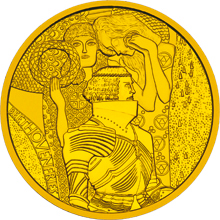Beethoven Frieze on:
[Wikipedia]
[Google]
[Amazon]
The ''Beethoven Frieze'' is a painting by Gustav Klimt on display in the
File:Klimt - Beethovenfries - linke Seitenwand - Ausschnitt1.jpg, Left wall: "the yearning for happiness; the sufferings of weak mankind; ..."
File:Klimt_-_Bethovenfries_-_linke_Seitenwand_-_Ausschnitt2.jpeg, "... their petition to the well-armed strong one, to take up the struggle for happiness, impelled by motives of compassion and ambition.
File:Klimt - Bethovenfries - Mittelwand.jpeg, Middle wall: the hostile forces; Typhoeus the giant, against whom even gods fought in vain; his daughters, the three Gorgons, who symbolise lust and lechery, intemperance and gnawing care. The longings and wishes of mankind fly over their heads."
File:Klimt - Beethovenfries - Rechte Seitenwand1.jpg, Right wall: "the yearning for happiness is assuaged in poetry. The arts lead us to the ideal realm in which we all can find pure joy, pure happiness, pure love. ..."
File:Klimt_-_Bethovenfries_-_Rechte_Seitenwand2.jpeg, "... Choir of angels from Paradise. 'Joy, lovely spark of heaven's fire, this embrace for all the world."
 Because of the frieze's fame and popularity, it was made the main motif of a collectors' coin: the Austrian 100 euro Secession Coin, minted on November 10, 2004. The reverse side features a small portion of the frieze. The extract from the painting features three figures: a knight in armor representing "Armored Strength", one woman in the background symbolizing "Ambition" holding up a wreath of victory and a second woman representing "Sympathy" with lowered head and clasped hands.
Because of the frieze's fame and popularity, it was made the main motif of a collectors' coin: the Austrian 100 euro Secession Coin, minted on November 10, 2004. The reverse side features a small portion of the frieze. The extract from the painting features three figures: a knight in armor representing "Armored Strength", one woman in the background symbolizing "Ambition" holding up a wreath of victory and a second woman representing "Sympathy" with lowered head and clasped hands.
''Beethoven Frieze'' in the online catalog of the Vienna Secession (in German)
*
video discussion about the painting from Smarthistory at
Secession Building
The Secession Building (german: Secessionsgebäude) is an exhibition hall in Vienna, Austria. It was completed in 1898 by Joseph Maria Olbrich as an architectural manifesto for the Vienna Secession, a group of rebel artists that seceded from the ...
, Vienna, Austria.
Description
In 1901, Klimt painted the ''Beethoven Frieze'' for the 14thVienna Secession
The Vienna Secession (german: Wiener Secession; also known as ''the Union of Austrian Artists'', or ''Vereinigung Bildender Künstler Österreichs'') is an art movement, closely related to Art Nouveau, that was formed in 1897 by a group of Austr ...
ist exhibition in celebration of the composer, and featured a monumental polychrome sculpture by Max Klinger. Meant for the exhibition only, the frieze
In architecture, the frieze is the wide central section part of an entablature and may be plain in the Ionic or Doric order, or decorated with bas-reliefs. Paterae are also usually used to decorate friezes. Even when neither columns nor ...
was painted directly on the walls with light materials. After the exhibition the painting was preserved, although it did not go on display again until 1986. The ''Beethoven Frieze'' is on permanent display in the Vienna Secession Building in a specially built, climate-controlled basement room.
The frieze is large, standing at 7 feet high with a width of 112 feet. The entire work weighs four tons.
Depiction on coin
 Because of the frieze's fame and popularity, it was made the main motif of a collectors' coin: the Austrian 100 euro Secession Coin, minted on November 10, 2004. The reverse side features a small portion of the frieze. The extract from the painting features three figures: a knight in armor representing "Armored Strength", one woman in the background symbolizing "Ambition" holding up a wreath of victory and a second woman representing "Sympathy" with lowered head and clasped hands.
Because of the frieze's fame and popularity, it was made the main motif of a collectors' coin: the Austrian 100 euro Secession Coin, minted on November 10, 2004. The reverse side features a small portion of the frieze. The extract from the painting features three figures: a knight in armor representing "Armored Strength", one woman in the background symbolizing "Ambition" holding up a wreath of victory and a second woman representing "Sympathy" with lowered head and clasped hands.
See also
* List of paintings by Gustav KlimtNotes
External links
''Beethoven Frieze'' in the online catalog of the Vienna Secession (in German)
*
video discussion about the painting from Smarthistory at
Khan Academy
Khan Academy is an American non-profit educational organization created in 2008 by Sal Khan. Its goal is creating a set of online tools that help educate students. The organization produces short lessons in the form of videos. Its website also in ...
{{Authority control
1902 paintings
Paintings by Gustav Klimt
Frieze
In architecture, the frieze is the wide central section part of an entablature and may be plain in the Ionic or Doric order, or decorated with bas-reliefs. Paterae are also usually used to decorate friezes. Even when neither columns nor ...
Vienna Secession
Paintings in Vienna